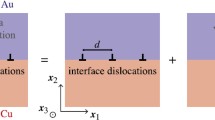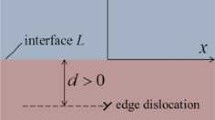Abstract
An isotropic elastic half-plane weakened by a Volterra dislocation, screw/edge is analyzed. The linear Gurtin–Murdoch surface elasticity theory is utilized to incorporate the surface effects. Therefore, the analysis is also valid for dislocations situated at a nanoscale distance from the boundary. The governing equations are derived in terms of displacement components. These equations are solved by means of the integral transform method. The resultant stress fields exhibit Cauchy as well as hyper-singular terms in the vicinity of dislocations. As the distance from dislocation to half-plane boundary increases, stress components tend to those of classical elasticity theory. Stress contours in the vicinity of screw and edge dislocations and plots of forces acting per unit length of dislocations in a thin elastic half-plane made up of glass substrate reinforced by an iron film are drawn. Stress contours reveal that surface effects magnify the stress field. Moreover, surface effects drastically change the behavior of force on a dislocation which is situated at a nanoscale distance from the stress-free half-plane boundary.








Similar content being viewed by others
References
Leibfried, G., Dietze, H.: Image force calculations for a screw dislocation. Z. Phys. 126, 290 (1949)
Head, A.K.: The interaction of dislocations and boundaries. Lond. Edinb. Dublin Philos. Mag. J. Sci. 44(348), 92–94 (1953)
Chu, S.N.G.: Screw dislocation in a two-phase isotropic thin film. J. Appl. Phys. 53(4), 3019–3023 (1982). https://doi.org/10.1063/1.331043
Bai, J., Wang, S.: Screw dislocation equations in a thin film and surface effects. Int. J. Plast. 87, 181–203 (2016). https://doi.org/10.1016/j.ijplas.2016.09.013
Gharahi, A., Dai, M., Schiavone, P.: Screw dislocation in a thin film–substrate in couple stress elasticity. Z. Angew. Math. Phs. 68(2), 1–23 (2017). https://doi.org/10.1007/s00033-017-0774-z
Wang, X., Schiavone, P.: Screw dislocation interacting with a biomaterial interface incorporating surface strain gradient elasticity. Eur. J. Mech. A/Solids 53, 254–258 (2015). https://doi.org/10.1016/j.euromechsol.2015.05.010
Dai, M., Schiavone, P.: Edge dislocation interacting with a Steigmann–Ogden interface incorporating residual tension. Int. J. Eng. Sci. 139, 62–69 (2019). https://doi.org/10.1016/j.ijengsci.2019.01.009
Gurtin, M.E., Murdoch, A.I.: A continuum theory of elastic material surfaces. Arch. Ration. Mech. Anal. 57(4), 291–323 (1975). https://doi.org/10.1007/BF00261375
Gurtin, M.E., Murdoch, A.I.: Surface stress in solids. Int. J. Solids Struct. 14, 431–440 (1978). https://doi.org/10.1016/0020-7683(78)90008-2
Miller, R.E., Shenoy, V.B.: Size-dependent elastic properties of nanosized structural elements. Nanotechnology 11, 139–147 (2000)
Dai, M., Schiavone, P.: Analytic solution for a line edge dislocation in a biomaterial system incorporation interface elasticity. J. Elast. 132, 295–306 (2018). https://doi.org/10.1007/s10659-017-9666-x
Dai, M., Schiavone, P., Gao, C.-F.: Screw dislocation in a thin film with surface effects. Int. J. Solids Struct. 110–111, 431–440 (2017). https://doi.org/10.1016/j.ijsolstr.2017.01.041
Grekov, M.A., Sergeeva, T.S., Pronina, Y.G., Sedova, O.S.: A periodic set of edge dislocations in an elastic semi-infinite solid with a planar boundary incorporating surface effects. Eng. Fract. Mech. 186, 423–435 (2017). https://doi.org/10.1016/jengfracmech017.11.005
Grekov, M.A., Sergeeva, T.S.: Interaction of edge dislocation array with biomaterial interface incorporating interface elasticity. Int. J. Eng. Sci. (2020). https://doi.org/10.1016/j.ijengsci.2020.103233
Eremeyev, V.A., Rosi, G., Naili, S.: Surface/interfacial anti-plane waves in solids with surface energy. Mech. Res. Commun. 74, 8–13 (2016). https://doi.org/10.1016/j.mechrescom.2016.02.018
Huang, Z.P., Wang, J.: A theory of hyper-elasticity of multi-phase media with surface/interface energy effect. Acta Mech. 182, 195–210 (2006). https://doi.org/10.1007/s00707-005-0286-3
Duan, H.L., Wang, J., Karihaloo, B.L.: Theory of elasticity at the nanoscale. Adv. Appl. Mech. 42, 50 (2008). https://doi.org/10.1016/S0065-2156(08)00001-X
Gorbushin, N., Eremeyev, V.A., Mishuris, G.: On stress singularity near the tip of crack with surface stresses. Int. J. Eng. Sci. 146, 103183 (2020). https://doi.org/10.1016/j.ijengsci.2019.103183
Dai, M., Gharahi, A., Schiavone, P.: Note on the deformation-induced change in the curvature of a material surface in plane deformation. Mech. Res. Commun. 94, 88–90 (2018). https://doi.org/10.1016/j.mechrescom.2018.10.001
Eshelby, J.D.: The force on an elastic singularity. Philos. Trans. A 244(877), 87–112 (1951). https://doi.org/10.1098/rsta.1951.0016
Author information
Authors and Affiliations
Corresponding author
Ethics declarations
Conflict of interests
The authors have no conflicts of interest to declare that are relevant to the content of this article.
Additional information
Publisher's Note
Springer Nature remains neutral with regard to jurisdictional claims in published maps and institutional affiliations.
Appendix
Appendix
The coefficients in Eq. (29) are
where
Rights and permissions
About this article
Cite this article
Rahimi, M., Vafa, J.P. & Fariborz, S.J. Analysis of Volterra dislocation in half-planes incorporating surface effects. Acta Mech 233, 2335–2350 (2022). https://doi.org/10.1007/s00707-022-03223-5
Received:
Revised:
Accepted:
Published:
Issue Date:
DOI: https://doi.org/10.1007/s00707-022-03223-5




